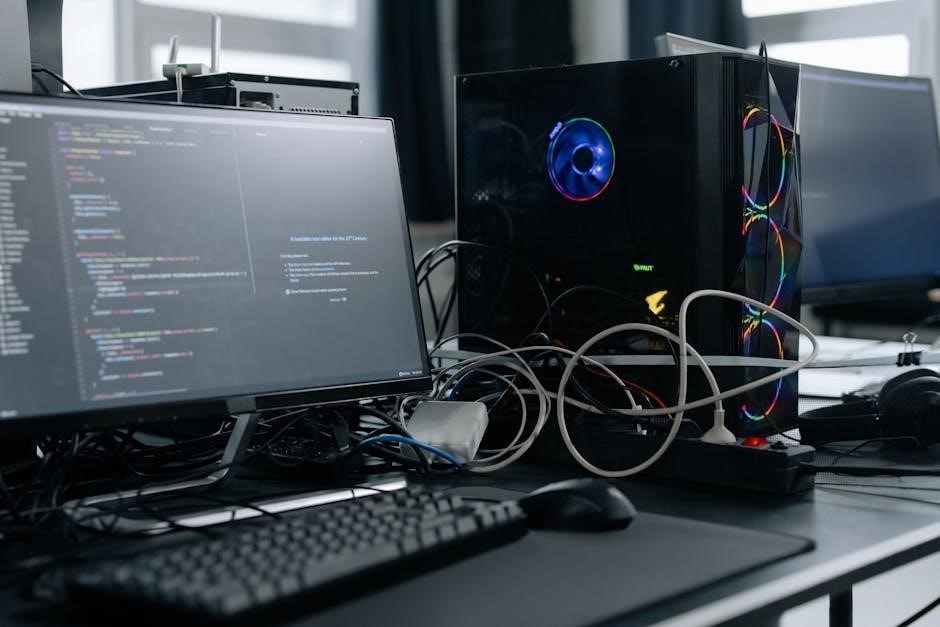how it works and why na pdf
- by laurianne

Anxiety and panic occur naturally‚ triggered by human alarm system‚ with anxiety being an emotion that helps face threats‚ and panic being an intense fear response‚ explained through cognitive-behavioral treatment methods online.
Understanding the Basics of Anxiety
Anxiety is a normal human emotion that helps individuals face threats and problems‚ and it is triggered by the human alarm system. The alarm system has two principal components‚ anxiety and panic‚ which work together to respond to perceived threats. Understanding the basics of anxiety is essential to managing and overcoming it. Anxiety can be caused by a variety of factors‚ including genetics‚ environment‚ and life experiences. It can also be triggered by certain situations or objects‚ and can manifest in different ways‚ such as fear‚ apprehension‚ or avoidance. According to online resources‚ anxiety is a common and treatable condition‚ and understanding its basics is the first step towards recovery. By learning about anxiety and how it works‚ individuals can better manage their symptoms and improve their overall well-being. Online resources‚ such as articles and guides‚ can provide valuable information and support for individuals seeking to understand and overcome anxiety.

Causes and Effects of Anxiety
Anxiety causes a range of effects‚ including emotional‚ physical‚ and behavioral symptoms‚ impacting daily life and overall well-being significantly always online.
How Anxiety and Panic Occur
Anxiety and panic occur through a complex process involving the human alarm system‚ which triggers an emotional response to perceived threats or dangers. This response is mediated by the brain’s amygdala and hippocampus‚ which process emotional information and memories. The alarm system has two principal components: anxiety and panic‚ which work together to prepare the body for the “fight or flight” response. When the alarm system is triggered‚ it can lead to a range of physical and emotional symptoms‚ including rapid heartbeat‚ sweating‚ and trembling. Understanding how anxiety and panic occur is essential for developing effective treatment strategies and learning to manage these conditions. By recognizing the underlying mechanisms that contribute to anxiety and panic‚ individuals can take the first step towards recovery and improved mental health. The process of anxiety and panic occurrence is closely linked to the individual’s thoughts‚ feelings‚ and behaviors.

Treatment Methods for Anxiety
Cognitive-behavioral therapy and relaxation techniques are effective treatment methods for anxiety‚ helping individuals manage symptoms and improve mental health online every day naturally.
Relaxation Techniques and Exposure Therapy
Relaxation techniques‚ such as abdominal breathing and progressive muscle relaxation‚ are essential components of anxiety treatment‚ helping individuals manage symptoms and reduce anxiety levels. Exposure therapy is also a crucial aspect‚ involving gradual exposure to feared situations or objects‚ allowing individuals to become comfortable and confident in their ability to cope. This type of therapy is often used in conjunction with relaxation techniques‚ providing individuals with the tools and strategies needed to manage anxiety and panic attacks. By learning and practicing relaxation techniques and exposure therapy‚ individuals can develop the skills and confidence needed to overcome anxiety and improve their overall mental health. Effective relaxation techniques and exposure therapy can be found online‚ providing individuals with access to a range of resources and support. These techniques are designed to help individuals manage anxiety and panic attacks‚ and can be used in conjunction with other treatment methods.

Managing Anxiety and Panic Attacks
Anxiety and panic attacks are managed through techniques like abdominal breathing and relaxation‚ helping individuals cope with symptoms and reduce anxiety levels naturally online every day.
Abdominal Breathing and Relaxation Techniques
Abdominal breathing and relaxation techniques are essential tools for managing anxiety and panic attacks‚ helping individuals calm their minds and bodies. These techniques involve slow‚ deep breathing‚ focusing on the abdominal area‚ and progressive muscle relaxation. By practicing these techniques‚ individuals can learn to control their anxiety symptoms and reduce their frequency and intensity. Online resources and cognitive-behavioral therapy can provide guidance on how to effectively use abdominal breathing and relaxation techniques. Regular practice can help individuals develop greater self-awareness and self-regulation‚ enabling them to better manage their anxiety and panic attacks. Additionally‚ these techniques can be used in conjunction with other therapies‚ such as exposure therapy‚ to enhance their effectiveness. Overall‚ abdominal breathing and relaxation techniques are valuable components of a comprehensive approach to managing anxiety and panic attacks‚ promoting relaxation and reducing symptoms. They can be easily incorporated into daily life‚ providing a sense of calm and control.

Accessing Treatment and Support
Individuals can access treatment and support through online resources‚ therapy sessions‚ and support groups‚ providing guidance and help for managing anxiety and panic attacks effectively every day online.
Guidance for Friends and Family of Individuals with Anxiety
Friends and family of individuals with anxiety can play a significant role in their recovery and management of anxiety and panic attacks. They can provide emotional support‚ encouragement‚ and help their loved ones access treatment and support. Online resources and therapy sessions can also provide guidance for friends and family on how to cope with their loved one’s anxiety. It is essential for them to understand the causes and effects of anxiety‚ as well as the different treatment methods available. By being informed and supportive‚ friends and family can help their loved ones manage their anxiety and improve their overall well-being. Additionally‚ support groups can provide a sense of community and connection for friends and family‚ allowing them to share their experiences and learn from others who are going through similar situations. This can be a valuable resource for them to cope with the challenges of supporting a loved one with anxiety.
Related posts:
Discover how PDF works and its magic at willhertz.com, your PDF guide
Posted in PDF